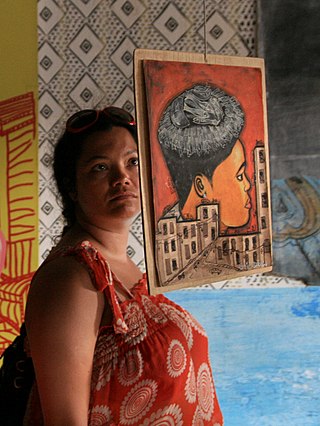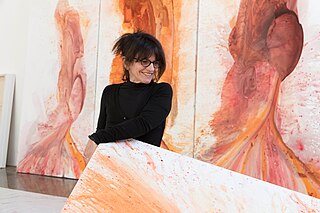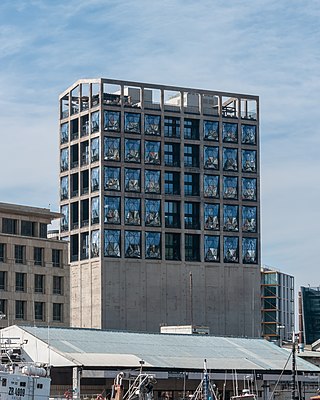David Goldblatt HonFRPS was a South African photographer noted for his portrayal of South Africa during the period of apartheid. After apartheid had ended he concentrated more on the country's landscapes. What differentiates Goldblatt's body of work from those of other anti-apartheid artists is that he photographed issues that went beyond the violent events of apartheid and reflected the conditions that led up to them. His forms of protest have a subtlety that traditional documentary photographs may lack: "[M]y dispassion was an attitude in which I tried to avoid easy judgments. . . . This resulted in a photography that appeared to be disengaged and apolitical, but which was in fact the opposite." He has numerous publications to his name.
Berni Searle is an artist who works with photography, video, and film to produce lens-based installations that stage narratives connected to history, identity, memory, and place. Often politically and socially engaged, her work also draws on universal emotions associated with vulnerability, loss and beauty.

Tracey Rose is a South African artist who lives and works in Johannesburg. Rose is best known for her performances, video installations, and photographs.
Athi-Patra Ruga is a South African artist who uses performance, photography, video, textiles, and printmaking to explore notions of utopia and dystopia, material and memory. His work explores the body in relation to sensuality, culture, and ideology, often creating cultural hybrids. Themes such as sexuality,Xhosa culture, and the place of queerness within post-apartheid South Africa also permeate his work.
Doreen Southwood is a South African artist, designer, and boutique owner based in Cape Town. She works in a wide variety of media in her artwork, producing sculptures, objects, prints, film, and more, which she often bases on personal experiences and self exploration. Her candidness regarding personal flaws and the cycles of repression and coping that accompany conservative, middle class, Afrikaans upbringing inform much of her work, calling attention to ways in which women are silenced or otherwise repressed in that space.
Mary Sibande is a South African artist based in Johannesburg. Her art consists of sculptures, paintings, photography, and design. Sibande uses these mediums and techniques to help depict the human form and explore the construction of identity in a postcolonial South African context. In addition, Sibande focuses on using her work to show her personal experiences through Apartheid. Her art also attempts to critique stereotypical depictions of women, particularly black women.
Wim Botha is a South African contemporary artist.
Jane Alexander is one of the most celebrated artists in South Africa. She is a female artist best known for her sculpture, The Butcher Boys. She works in sculpture, photomontages, photography and video. Alexander is interested in human behavior, conflicts in history, cultural memories of abuse and the lack of global interference during apartheid. Alexander's work is relevant both in the current Post- Apartheid social environment in South Africa and abroad.

Koyo Kouoh is Cameroonian-born curator who has been serving as Executive Director and Chief Curator of the Zeitz Museum of Contemporary Art Africa in Cape Town since 2019. In 2015, the New York Times called her "one of Africa’s pre-eminent art curators and managers", and from 2014 to 2022, she was annually named one of the 100 most influential people in the contemporary art world by ArtReview.

Penny Siopis is a South African artist from Cape Town. She was born in Vryburg in the North West province from Greek parents who had moved after inheriting a bakery from Siopis maternal grandfather. Siopis studied Fine Arts at Rhodes University in Makhanda, completing her master's degree in 1976, after which she pursued postgraduate studies at Portsmouth Polytechnic in the United Kingdom. She taught Fine Arts at the Technikon Natal in Durban from 1980 to 1983. In 1984 she took up a lectureship at the University of the Witwatersrand in Johannesburg. During this time she was also visiting research fellow at the University of Leeds (1992–93) and visiting professor in fine arts at Umeå University in Sweden (2000) as part of an interinstitutional exchange. With an honorary doctorate from Rhodes University, Makhanda – Siopis is currently honorary professor at Michaelis School of Fine Art, University of Cape Town.

Wayne Barker, South African visual artist. Barker is based in Johannesburg. He rose to prominence in the late 80s, at the height of political unrest under the Apartheid regime. His work has featured in several global biennales, art fairs and important retrospective exhibitions. He works in various mediums, including but not limited to painting, printmaking, sculpture, video, performance and installation. In addition to collaborations with other artists, Barker has collaborated with the Qubeka Beadwork Studio based in Cape Town, to realise large scale glass beadworks.
iQhiya is a network of young black women artists based in Cape Town and Johannesburg, South Africa. They specialise in a broad range of artistic disciplines including performance art, video, photography, sculpture and other mediums.

Zeitz Museum of Contemporary Art Africa is a public non-profit museum in Cape Town, South Africa. Zeitz MOCAA opened on September 22, 2017 as the largest museum of contemporary art from Africa and its diaspora. The museum is located in the Silo District at the Victoria & Alfred Waterfront in Cape Town. A retail and hospitality property, the Waterfront receives around 24 million local and international visitors per year.

Senzeni Marasela is a South African visual artist born in Thokoza who works across different media, combining performance, photography, video, prints, textiles, and embroidery in mixed-medium installations. She obtained a BA in Fine Arts at the Wits School of Arts, University of the Witwatersrand, Johannesburg in 1998. Her work is exhibited in South Africa, Europe, and the United States. It is part of local and international collections, including Museum of Modern Art or the Newark Museum, and is referenced in numerous academic papers, theses journals, and book publications.
Mmakgabo Mmapula Mmangankato Helen Sebidi is a South African artist born in Marapyane (Skilpadfontein) near Hamanskraal, Pretoria who lives and works in Johannesburg. Sebidi's work has been represented in private and public collections, including at the National Museum of Women in the Arts, Washington and New York the Smithsonian National Museum of African Art, New York, and the World Bank. Her work has been recognised internationally and locally. In 1989 she won the Standard Bank Young Artist award, becoming the first black woman to win the award. In 2004, President Thabo Mbeki awarded her the Order of Ikhamanga in Silver – which is the highest honor given to those considered a "national treasure". In 2011, she was awarded the Arts and Culture Trust (ACT) Lifetime Achievement Award for Visual Art, whilst in 2015 she received the Mbokodo Award. In September 2018, Sebidi was honoured with one of the first solo presentations at the Norval Foundation in Cape Town – a retrospective entitled Batlhaping Ba Re.

Sethembile Msezane is a South African visual artist, public speaker and performer who is known for her work within fine arts. Msezane uses her interdisciplinary practice which combines photography, film, sculpture, and drawing to explore issues focused on spirituality, politics and African knowledge systems. Part of her works focus has been on the process of myth-making and its influence on constructing history as well the absence of the black female body in both narrative and physical spaces of historical commemoration. Msezanes work is held in galleries in South Africa as well as internationally and has won awards and nominations. Msezane is a member of the iQhiya Collective, a network of black women artists originating from Cape Town, Johannesburg and across South Africa.
Bronwyn Katz is a South African sculptor and visual artist. She is a founding member of iQhiya Collective, a network of young black female artists based in Cape Town and Johannesburg, South Africa.
Lungiswa Gqunta is a South African sculptor and visual artist. Her work has been shown in several galleries and exhibitions including Zeitz Museum of Contemporary Art Africa, Johannesburg Art Gallery, Kunsthal Zurich and Nelson Mandela Metropolitan University, University of Cape Town.
Gerald Machona is a Zimbabwean contemporary visual artist. The most recognizable aspect of his work is his use of decommissioned Zimbabwean dollars. Machona works in sculpture, performance, new media, photography and film. In Machona's work, he explores issues of migration, transnationality, social interaction and xenophobia in South Africa.
Thania Petersen is a multi-disciplinary artist. Her work is in the collections of notable museums and galleries including the Smithsonian's National Museum of African Art and the Zeitz Museum of Contemporary Art Africa.







